I’ve been reading a text that was complied in the second half of the eighteenth century by Ngô Thì Sĩ (1726-1780). It is called the Former Compilation of the Historical Records of Đại Việt (Đại Việt sử ký tiền biên 大越史記前編).
This text is an account of Việt history up through the period of Ming Dynasty rule in the early fifteenth century. That period of history had earlier been compiled in the late-fifteenth-century work, the Complete Book of the Historical Records of Đại Việt (Đại Việt sử ký toàn thư 大越史記全書).
This is why Ngô Thì Sĩ referred to his text as the “former compilation,” as it was repeating what had previously been written. I think this is also why I have had Vietnamese scholars tell me that this text is not really important, because “there is nothing new” in it (không có gì mới cả).
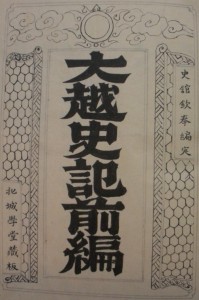
In terms of the information about the past that it contains, it is true that there is not much that is “new” in this text. However, Ngô Thì Sĩ left his own extensive comments about Việt history throughout this work, and that information is in fact “new.” Many of these comments also appear in another history that Ngô Thì Sĩ compiled, Model Cases from Việt History (Việt sử tiêu án 越史標案), however in the Former Compilation, Ngô Thì Sĩ expanded his comments by adding new information.
Ngô Thì Sĩ’s comments in the Former Compilation are therefore definitely worth reading, particularly since he expresses some of the most critical views of the Việt past that I have ever encountered a premodern scholar make. He is especially ruthless in deconstructing the earliest period of Việt history, the time of the mythical Hồng Bàng Dynasty.
However, he also expresses strong views about other periods, and one such case is his view of a period that the Complete Book covered in a section called “the Annals of the Triệu/Zhao” (Triệu kỷ 趙紀). This covered the years from 207-111 BC when a dynasty known as the Triệu/Zhao Dynasty purportedly ruled over the Red River Delta region.
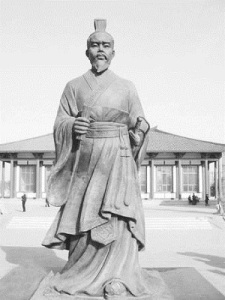
The founder of this dynasty was Triệu Đà/Zhao Tuo, a Qin Dynasty official who established his own kingdom from his base in what is now Guangdong Province called the Kingdom of Nam Việt/Nanyue (literally, “Southern Việt/Yue”), and who, according to the Complete Book, also conquered the Red River Delta from a man named King An Dương, who had in turn recently conquered that same region from a ruler referred to as the Hùng king.
After establishing his Kingdom of Nanyue, Zhao Tuo declared himself to be an “emperor,” and this fact is glorified in the Complete Book where Zhao Tuo is presented as a part of a long line “royal succession” (quốc thống 國統) from one sovereign to another throughout thousands of years of Việt history.

Ngô Thì Sĩ did not agree with this view of the past. He argues in his Former Compilation that while Zhao Tuo declared himself to be “king of the Southern Việt/Yue,” the Việt/Yue in the areas of what are now Guangdong and Guangxi provinces, where Zhao Tuo was based, were not the same as the Việt/Yue in the Red River Delta region.
What is more, Ngô Thì Sĩ argues, is that Zhao Tuo never really ruled as a sovereign (quân 君) over the Red River Delta region. Instead, he simply sent “overseers” (giám chủ giả 監主者) to govern over the region using something like the “loose reigns” (ki mi 羁縻) technique, a technique for ruling over foreign peoples that the Tang Dynasty developed whereby local rulers were essentially left to rule over their own people, provided that those local rulers remained loyal and offered tribute.
As such, to Ngô Thì Sĩ the Red River Delta region was more like a “vassal state” (thuộc quốc 屬國) of the Kingdom of Nanyue than an actual part of it, but he also felt that it was even less significant than that.
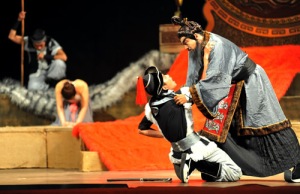
In reading what Ngô Thì Sĩ wrote, it is easy to detect a kind of unstated view of reality that he held. That view was that the Middle Kingdom served as a kind of “center,” and that around it were vassal states, or what we could simply call “possessions” of the Middle Kingdom.
While Zhao Tuo initially declared himself to be an emperor, he later agreed to become a vassal state of the Middle Kingdom. So in Ngô Thì Sĩ’s mind, that meant that the Red River Delta region became under the rule of the Zhao something like “a vassal state of a vassal state.” The term he used to describe this was “vassal commandery” (thuộc quận 屬郡).
Ngô Thì Sĩ therefore felt that it was incorrect to view Zhao Tuo as a sovereign of “Our Kingdom” (Ngã Quốc 我國), as he usually referred to the Red River Delta region. It was therefore also incorrect to place information about Zhao Tuo in a section of a history entitled “annals” (kỷ 紀), because annals recorded the history of sovereigns of kingdoms, and Zhao Tuo, according to Ngô Thì Sĩ, was not a sovereign of “Our Kingdom.”
Ngô Thì Sĩ thus changed the title of this section to “external possession” (ngoại thuộc 外屬), to indicate the time when “Our Kingdom” was the “possession” of an “external” polity.
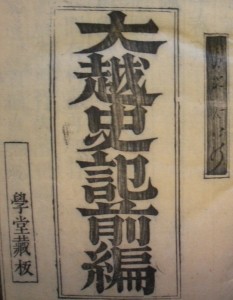
Here again we see his unstated view of reality. The Red River Delta region was later incorporated directly into the Han Dynasty empire. This period is referred to in the Complete Book as the period of “internal possession” (nội thuộc 内屬), that is, the time when the Red River Delta region “belonged” to “the center,” the Middle Kingdom.
Under the Zhao family’s rule, however, the Red River Delta region “belonged” to a kingdom that was “outside” of “the center.” It was thus the “possession” of a polity that was “external” to “the center.”
Ngô Thì Sĩ has other interesting points that he makes, so I am appending a translation of his entire comment below. Needless to say, I find that there is a lot that is “new” in what Ngô Thì Sĩ had to say in the sense that it reveals strong “counter views” to what has now become an “official narrative.”
Reading what Ngô Thì Sĩ wrote in the eighteenth century thus makes me wonder – if he could think this critically about the past at that time, why can’t many people do the same today?
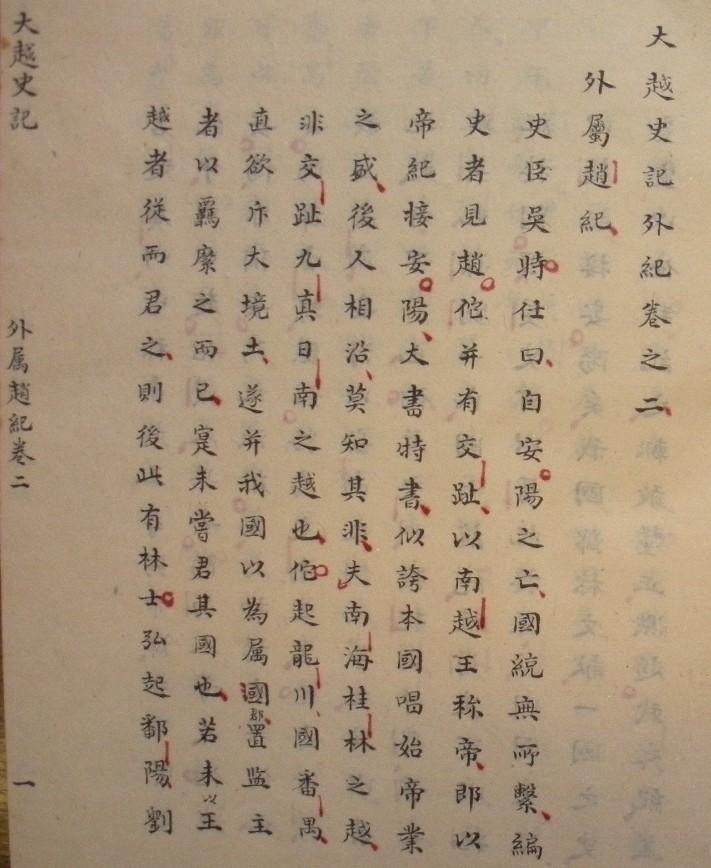
[1a] Historian Ngô Thì Sĩ stated, “With the fall of [King] An Dương, there was no one to continue the royal succession [quốc thống 國統]. Those who compile histories saw that Zhao Tuo annexed Giao Chỉ, and that as the King of Nam Việt/Nanyue he declared himself to be an emperor, so they placed him after An Dương in the imperial annals [đế kỷ 帝紀]. They wrote glowingly of him, apparently to boast about the magnificence of the beginnings of an imperial tradition in our kingdom. Later people continued this, and none of them knew that this is wrong.
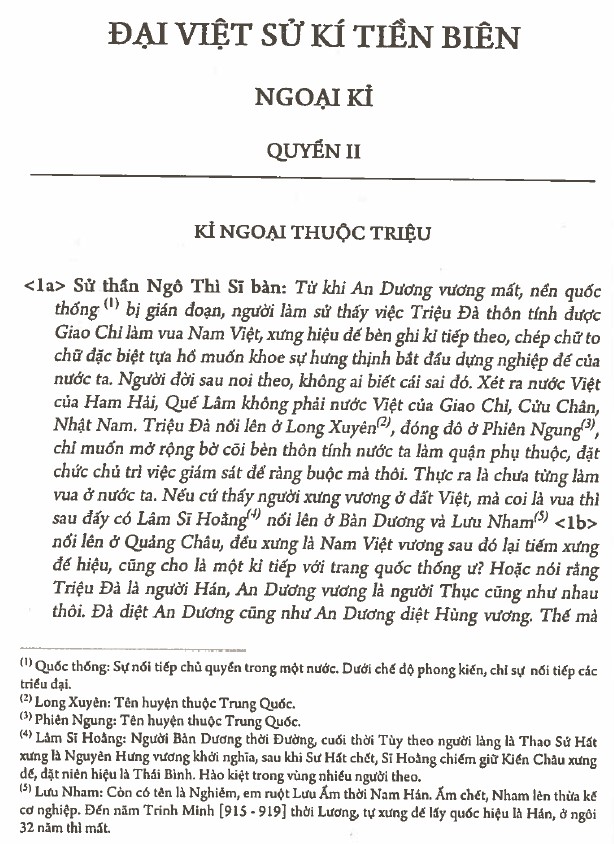
The Việt/Yue of Nam Hải/Nanhai and Quế Lâm/Guilin are not the same as the Việt/Yue of Giao Chỉ, Cửu Chân and Nhật Nam. Tuo rose up in Longchuan and established a kingdom at Panyu [in Guangdong], and wished to open up a vast expanse of land. He thereupon annexed our kingdom as a vassal commandery [thuộc quận 屬郡], and just placed overseers [giám chủ giả 監主者] there to keep it on loose reigns [ki mi 羁縻]. In fact, he was never a sovereign of [our] kingdom. If one takes those who have ruled over the Việt/Yue and call them sovereigns, then later there was Lin Shihong in Panyu and Liu [1b] Yan in Guangzhou who both declared themselves to be King of Nam Việt/Nanyue but secretly referred to themselves as emperors. Can they also be included in the annals?
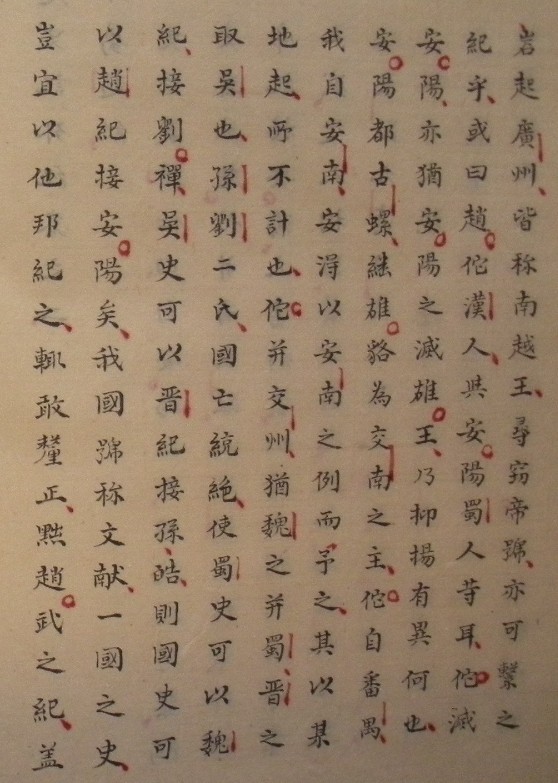
One could say that since Zhao Tuo was a Han person and An Dương was a Shu person that they were the same. Tuo’s elimination of An Dương was like An Dương’s elimination of the Hùng king. So in what way can [these two] be assessed differently? An Dương’s capital was at Cổ Loa and he coninued the Hùng Lạc [royal tradition] as the master of Giao Nam. [Zhao] Tuo was in Panyu, while we are in Giao Nam, so how can one take the example of An Dương [as a ruler of Giao Nam] and apply it to [Zhao Tuo]? Where did he rise up from? This is not noted.
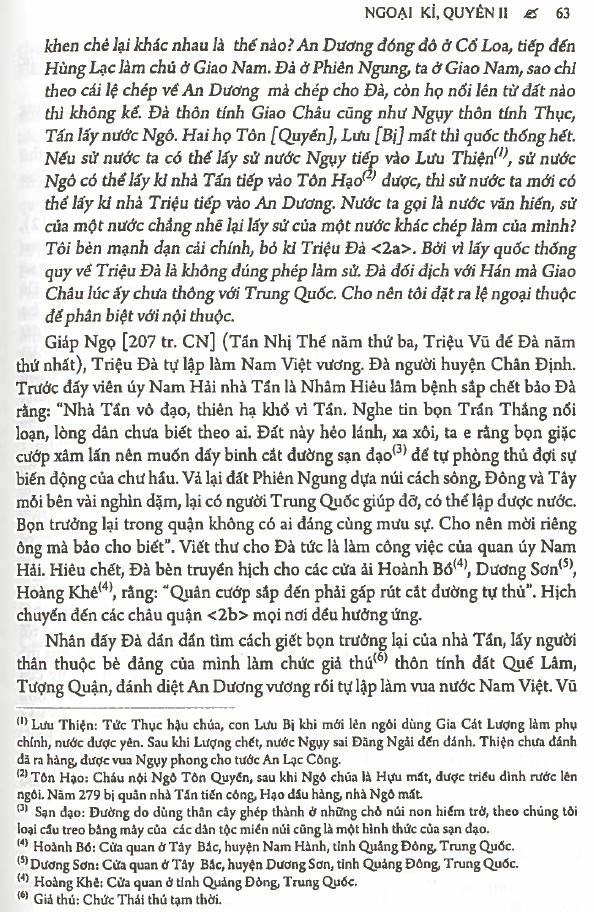
[Zhao] Tuo’s annexation of Giao Châu/Jiaozhou was like Wei’s annexation of Shu and Jin’s annexation of Wu. When the Sun and Liu clans lost their kingdoms, royal succession came to an end. If one can use the Wei annals to continue the history of Shu from Liu Shan [i.e., the final ruler of the Kingdom of Shu] and one can use the Jin annals to continue the history of Wu from Sun Hao [i.e., the final ruler of the Kingdom of Wu], then one will be able to use the Zhao annals to continue our kingdom’s history from An Dương.
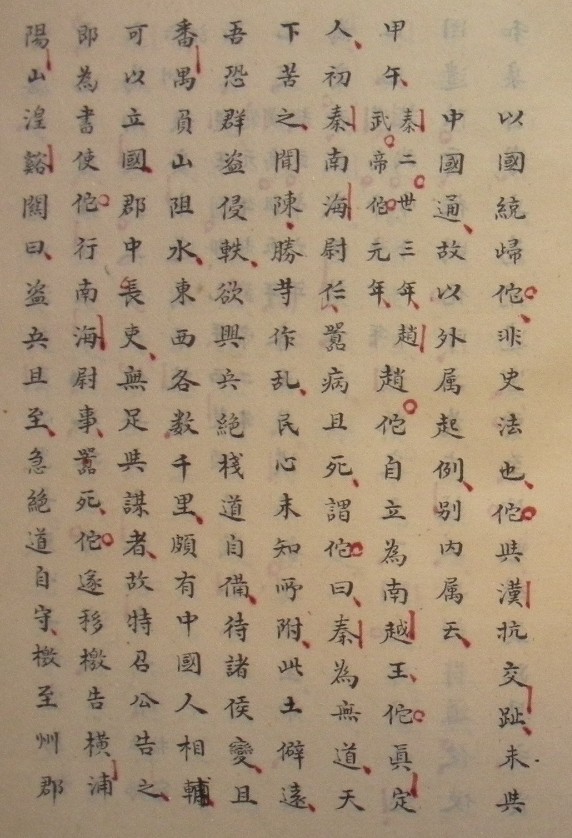
Our kingdom is called a domain of manifest civility. How is it appropriate for one kingdom’s history to rely on the annals of another domain? I am therefore correcting this and am demoting the annals of the Marshal [Emperor] of Zhao. [2b] To have royal succession continue with [Zhao] Tuo does not follow the standards of history. [Zhao] Tuo resisted the Han. Giao Chỉ had yet to establish intercourse with the Middle Kingdom. Therefore, I am using the category of external possession [ngoại thuộc 外屬] to differentiate from internal possession [nội thuộc 内屬].
This Post Has 5 Comments
Sir, do you have the PDF file of the whole Đại Việt sử ký tiền biên 大越史記前編 in Chinese? Thank you
I don’t have a pdf of the printed edition, although there is an online version here:
http://www.nomfoundation.org/nom-project/History-of-Greater-Vietnam?uiLang=en
At the bottom of this post are searchable files of the Han and quoc ngu texts:
https://leminhkhai.wordpress.com/2017/04/11/digital-humanities-bronze-drums-and-buffaloes/
It would be very interesting to know how do the today Cantonese look upon Zhao Tuo . Do they consider him as their own , ruler of a glorious past ?
Anyhow , according to Wikipedia , https://en.wikipedia.org/wiki/Cantonese_people , the Cantonese consider themselves as ” Tang people ” :
[under subsequent dynasties such as the Jin Dynasty, the Tang Dynasty and the Song Dynasty , major waves of Han Chinese began to migrate south into Guangdong and Guangxi. Waves of migration and subsequent intermarriage meant that existing populations of both provinces were displaced, but some native groups like the Zhuangs still remained. The Cantonese often call themselves “people of Tang” (唐人; tòhng yàhn). This is because of the inter-mixture between native and Han immigrants in Guangdong and Guangxi reached a critical mass of acculturation during the Tang dynasty, creating a new local identity among the Liangguang peoples.
During the 4th–12th centuries, Han Chinese people from North China’s Yellow River delta migrated and settled in the south of China. This gave rise to peoples including the Cantonese themselves, Hakkas and Hoklos, whose ancestors migrated from Henan and Shandong, to areas of southeastern coastal China such as Chaozhou, Quanzhou and Zhangzhou and other parts of Guangdong during the Tang dynasty.[17] There have been multiple migrations of Han people into southeastern and southern China throughout history.[18]
The origin of the Cantonese people is thus said to be northern Chinese peoples that migrated to Guangdong and Guangxi while it was still inhabited by Baiyue peoples.[19] During Wang Mang’s reign in the Han dynasty (206BC-220AD), there were influxes of Han Chinese migrants into Guangdong and Guangxi, western coast of Hainan, Annam (now Northern Vietnam) and eastern Yunnan ]
Annam must have been also populated by different waves of ” chinese ” migrants .
How come the modern Vietnamese come to the crazy idea , they remain Baiyue people with a different culture ?
Zhao Tuo ‘s son Zhao Mi ruled for some years before losing it all to the Han dynasty . His tomb was discovered later and his body was brought into a museum , Mausoleum of the Nanyue King ;
The most impressive artifact is his burial suit made up from thousand of pieces of jade connected by silk , unique of its kind in the world
Erratum :
Zhao Tuo ‘s son ‘s name is Zhao Mo 趙眜 , Triệu Mạt
I think we have a misunderstanding here, sir. I’m looking for the chinese version of Đại Việt sử ký TIỀN BIÊN not Đại Việt sử ký TOÀN THƯ or Đại Việt sử ký TỤC BIÊN. But thank you anyway, sir!